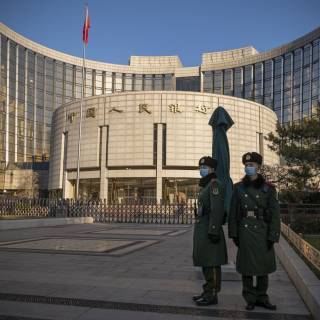(Bloomberg) -- China’s central bank stepped up support for its slowing economy by pumping in cash via policy loans for a second straight month. The benchmark stock index advanced, outperforming regional equities.
The People’s Bank of China injected a net 100 billion yuan ($15.7 billion) into the banking system with its medium-term lending facility, while leaving the borrowing rate unchanged. The CSI 300 rose as much as 1.1%.
Chinese banks in January extended a record amount of loans after the PBOC lowered borrowing costs for the first time since 2020 last month. The latest move, seen as a prelude by many to further easing, comes as the economy struggles with repeated Covid outbreaks, a slowdown in the property sector and signs of weak domestic demand.
“This sends the signal from the PBOC that it’s still willing to keep liquidity conditions quite ample and market rates at relatively low level to support credit demand,” said Zhi Xiaojia, economist at Credit Agricole CIB in Hong Kong. “There is room for further policy actions in 1H, including both RRR and policy rate cuts, as growth pressures remain, especially in the property sector and related to private consumption demand.”
Sixteen of the 27 economists polled by Bloomberg saw the central bank keeping the interest rate on its one-year policy loans unchanged, with most saying the PBOC can afford to wait and see whether earlier easing measures are taking effect.
In January, the central bank cut the rate on its one-year policy loans by 10 basis points to 2.85%, the first reduction since April 2020.
Still, there’s a growing chorus of economists and investors calling for more support, with Citic Securities Co. saying that a cut in the reserve requirement ratio for banks could be seen as early as March. In its quarterly report last week, the PBOC pledged to keep its monetary action “ample, targeted and front-loaded.”
What Bloomberg Economics Says...
The People’s Bank of China is catching its breath after it cut the one-year medium-term lending facility rate last month -- the pause won’t last long. The central bank has signaled it’s ready to deliver more support to prop up growth. We expect the next cut as soon as the second quarter, and see the PBOC delivering another one in 3Q -- part of a broader array of easing measures to counter the slowdown.
--David Qu and Chang Shu, China economists
For the full report, click here
Despite the decision to hold the one-year policy loan rate steady Tuesday, the PBOC’s easing stance has set it apart from other major central banks including the Federal Reserve, which are tightening monetary policy to tame soaring inflation. The possibility that the Fed will accelerate the pace of rate hikes could restrict China’s room for further easing later this year as it could accelerate outflows.
Global demand for Chinese bonds has already slipped amid their shrinking yield premium. The yield gap on China’s 10-year sovereign bonds over similar-maturity Treasuries narrowed to 73 basis points last week, the least since 2019.
Stocks Cheer
Tuesday’s gains in stocks marks a reprieve after a torrid start to the year. The benchmark CSI 300 Index plunged into a bear market last month as worries about a weak economy and property-sector debt outweighed PBOC’s monetary easing. The index is down nearly 7% so far in 2022 to be the second-worst performer among Asian stock benchmarks after South Korea.
“Despite today’s MLF decision, I expect China to further ease monetary policies in the first half of 2022,” said Lloyd Chan, Senior Investment Strategist of Wealth Management at Citibank NA. “That’s why the performance of Chinese equities can be better this year and there may be double-digit potential upside.”
Inflation data due Wednesday will likely indicate further room for easing. Economists polled by Bloomberg expect consumer prices to rise 1% from a year ago in January, slowing from the 1.5% gain in the previous month. Producer prices are forecast to climb 9.5%, also slower than the 10.3% advance in December. The PBOC has said that inflation pressure is “controllable” and that consumer inflation will continue to be within a reasonable range, while factory-gate inflation decelerates.
Here’s a table on forecasts for PBOC easing this year:
(Updates with Citibank comment in 11th paragraph and inflation data in 12th.)
More stories like this are available on bloomberg.com
©2022 Bloomberg L.P.
